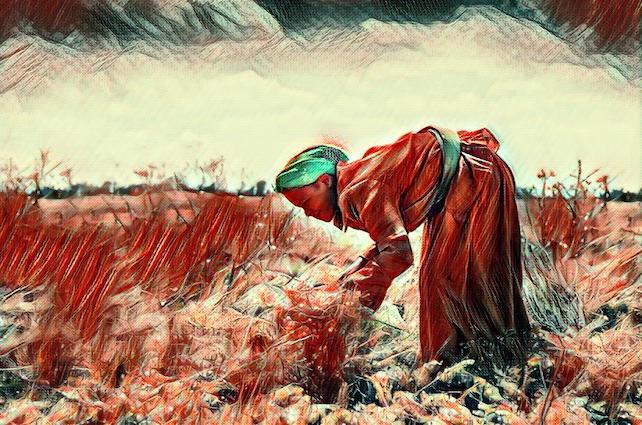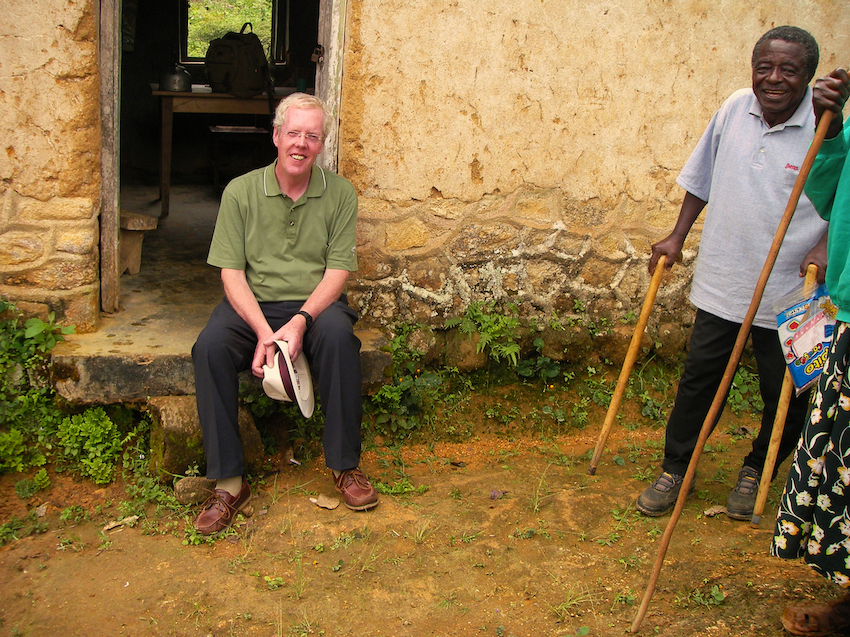The umbilical cord

“Sum up Africa for me. What image would you give that would tell me what Africa is all about?”. That is what a friend once asked me one warm night sitting with a beer out in my back garden.
So many images came to mind. Children everywhere, hundreds of them. Joyful, boisterous, innocent, mischievous, always together, noisy. Old men sitting at their front door, sleeping in the sun, dreaming of their youth. Puffed-up civil servants, sweating in tight suits, strutting about giving orders to remind everyone of their importance. The old village chief listening patiently to his people bringing complaints. Land palavas – the never-ending disputes about boundaries. Dancers whirling in the dust at sunset. The chaos of the traffic in African cities. And many more.
But of all the images which, to me, sums up Africa, what its essence is, the one that always comes to mind would be looking out on a hillside where a woman is bent low with her baby strapped to her back, hoeing the red earth, the afternoon silence broken by the occasional call of a bird and the sound of her hoe rising and falling, tilling the rich, dark soil.
That for me is Africa. The connection with the land. Life and care. The giving and the receiving. The cycle of seasons. A woman in harmony with the natural world and an integral part of it.
The reality
There is a danger, though, of idealising and romanticising the rural African experience. Life there is hard, especially for women. The harshness of living in the African bush perhaps goes some way to explaining why 40 per cent of people in Sub-Saharan Africa now live in cities.
Most cities in sub-Saharan Africa are new. Each day they grow and expand chaotically outwards, where temporary dwellings spring up and form a crown of thorns circling the city - slums filled with appalling poverty and squalor. People there retain some connection with the village back home and try to maintain the dignity and values they brought with them but with each new generation, the old language is spoken less and less, the culture is forgotten and the land is no longer cherished, defended or remembered.
This is a story many of us in Scotland are familiar with. Our ancestors moved from Ireland or from the highlands and islands to live in poverty in the slums of Glasgow, Edinburgh or around the pits and steelworks of Lanarkshire. They were people escaping hardship or famine only to find themselves exploited by a system which was focused on the wellbeing of a privileged few. My own ancestors came from the farmlands of middle Ireland, from the highlands of Scotland and, like most young people from the Hebrides, my great-grandmother, Annie Maclean, moved to the Central Belt in search of a better life. 160 years later at the family gatherings, the old songs are sung less and less and the Irish and the Gaelic are no longer heard from our lips. Our culture has become generic, coca-colonialised with only a faint touch of local colour.
Are our lives better than those who came before us? Probably – in many ways. We have more freedom, more choices and more control over our lives but with these also comes more responsibility. People are better and stronger than what the greedy can throw at them. The slums of Africa, as with those before in our own country, are filled with kindness as well as strife, with heroism as well as fear, with a deep sense of community in the midst of shared trials. The human spirit more often than not aspires to goodness.
The earth and the poor
How we treat the poor mirrors how we treat the earth and vice versa. What is important and valuable is often the weakest and most vulnerable. That is why Pope Francis, in his encyclical Laudato Sii, links the treatment of the earth with the treatment of the world’s poor. The reality on our planet is that the deck is stacked against the poor. At best they are cheap labour serving to profit the greedy in a rigged global economy, at worst they are unwanted migrants to whom we close our borders. We can only be properly human, he tells us, if we share and respect the earth in a way that includes respecting and sharing the planet’s wealth with all our brothers and sisters. The Covid pandemic has made it apparent that in our vulnerability we are connected.
In the culture of the people I lived with in Cameroon there was a custom that the umbilical cord of a new-born child was buried in the land around the homestead. The symbolism is clear. It was this land that gave you life, will continue to give you life and it is into this land that you will return.
If we respect the earth – the place where we were born – we must also care for one another, especially those who are most in need. Only then will we find our connection with who we really are, with one another and with the place we call our common home, the cord that unites us to those who came before us and to those who will come after us.
An talamh a tha a ’caoidh
(The land which grieves)
O my child, I bore you
and I grieve to see you go.
I am the land that holds your father's dreams
and your mother's songs and tears.
Turn to me
although your hope now leads you far from here.
Turn to me
and I will speak my love.
For I shall be now forsaken
as you take from me your soul.
Memory will fade now from this place
and a silence cover me.
Remember me
when the road is long and dark.
Remember me
at the dying of your light.
Vincent Lockhart
